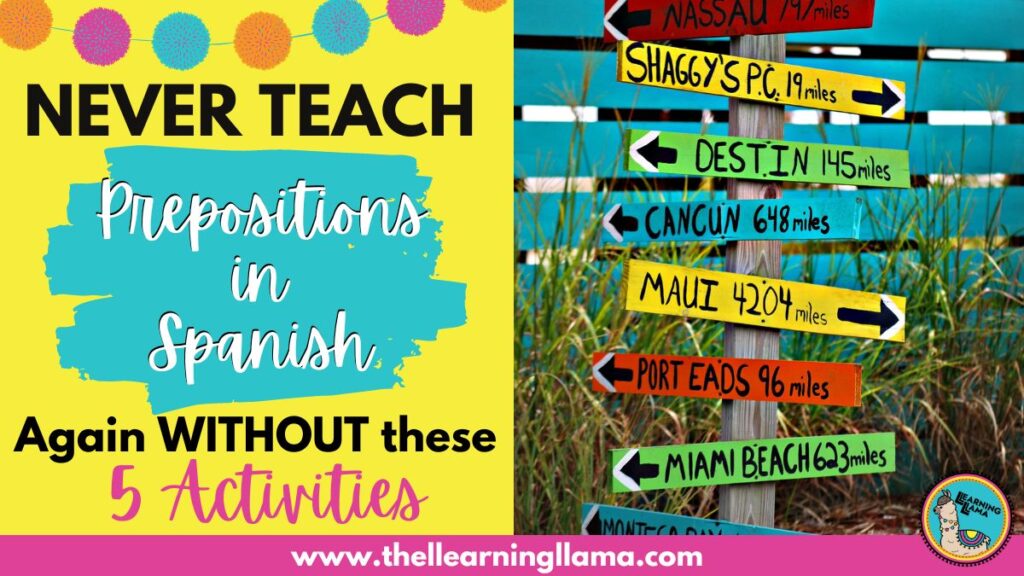I remember teaching prepositions in Spanish when I first taught Spanish 2. It accompanied a unit for places around town and giving directions. I felt like we spent the entire unit just staring at maps and describing the location of each place, then giving directions from A to B. I was bored, and I knew my students were, too. If you’re stuck in a rut with teaching prepositions in Spanish, then you will love these exciting activities. They can be used with any vocabulary and for any level of student.
Prepositions Grids
Using what I call “preposition grids” is one of my favorite ways to practice prepositions in Spanish with my students. The best part about using a preposition grid is that there are countless activities you can do with it, and it works for any unit and any vocabulary. All it requires is a 4×4 grid, some sentences, and vocabulary!
Before you begin any of these preposition grid activities, you will need to have 16 vocabulary words that your students know. Make sure the words are easy to draw or find clipart for. I have taught prepositions in Spanish during a school supply unit (The pencil is on top of the book.) But I think the most common time we teach prepositions of place is with places around town and giving directions (The supermarket is to the left of the gas station.)
However, you can use the preposition grid as a vocabulary activity, with a focus on the terms and the prepositions take a backseat and serve as the method for teaching and reviewing vocabulary in a fun way. I did that with Day of the Dead vocabulary, animals, and fruits and vegetables. It is just a fun way to spice up our normal vocabulary reviews!
Here are 4 ways you can use preposition grids.
1. Listen and Draw
Give students a blank 4×4 grid with one image on the grid to serve as the starting point. Or as a literal no-prep lesson, just pass out blank paper and have them fold it into 16 boxes! You will use the one image on the grid as your starting point (see below.) Then, using simple sentences with prepositions, describe the location of the next image, and so on until the grid is complete. As students listen to each sentence, they will draw the image in the appropriate box. The sentences can be read aloud or can be written for students to read at their own pace… both serve as interpretive tasks!
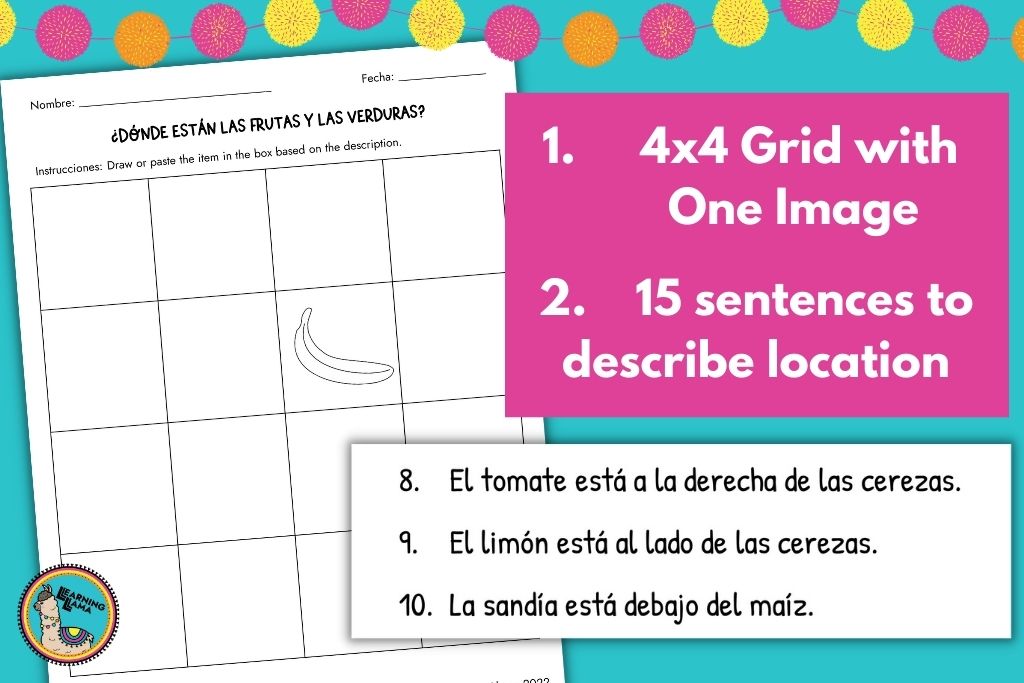
2. Cut and Paste
For a fun manipulative activity, you will have a grid completed (in a mixed up order) with clipart of all 16 vocabulary terms. Students will cut out all 16 images in preparation for the activity. Again, you will need sentences for your students to listen to or read as they put the grid back together in the right order. This version of the preposition grid activity does not require drawing like the first activity, but does require cutting and pasting (or just rearranging!)
3. Info Gap
As with any info gap, your students will practice interpersonal speaking. Each student needs a partner, and each partner will have half of a completed grid. They will NOT show their partner their grid. The goal is for each student to successfully describe where each item is on their grid so as their partner listens, they can draw it on their own paper and fill in the grid. At the end, have your students compare grids to make sure they look identical.
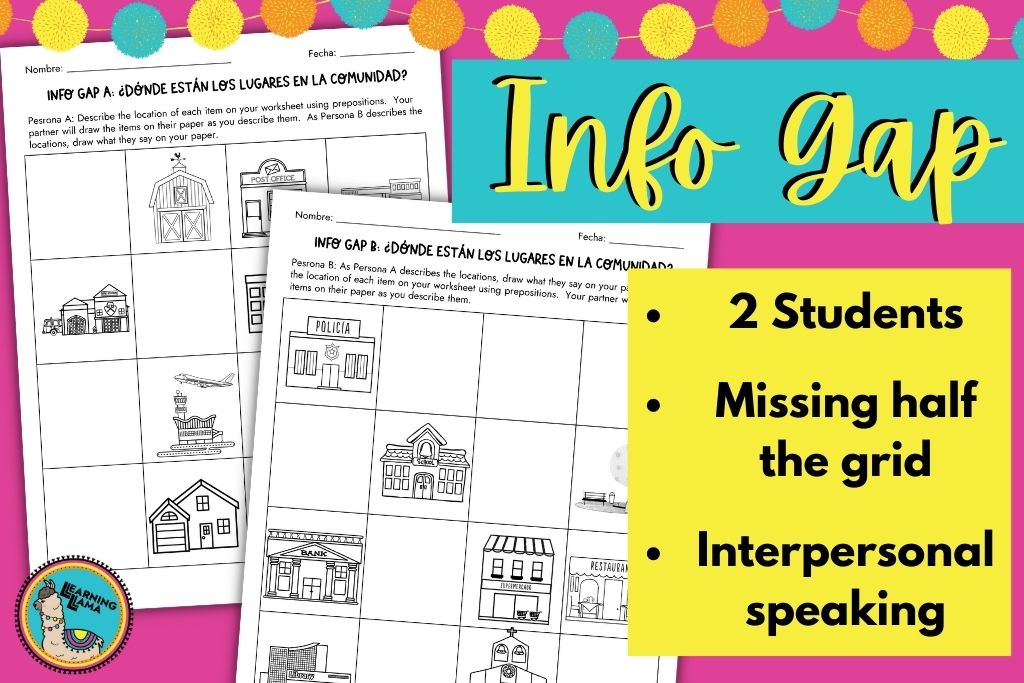
4. Describe the grid
After students have a completed preposition grid, filled in with images, then the final step is to have them describe the grid. (You could also give them a completed grid if you’re short on time.) Now, students get to do the speaking or writing. As they view the completed grid, they will write complete sentences describing the location of the various images. To differentiate this activity, your advanced students can write complete sentences on their own, but your lower level students that need more support can complete fill-in-the-blank sentences with the correct preposition.
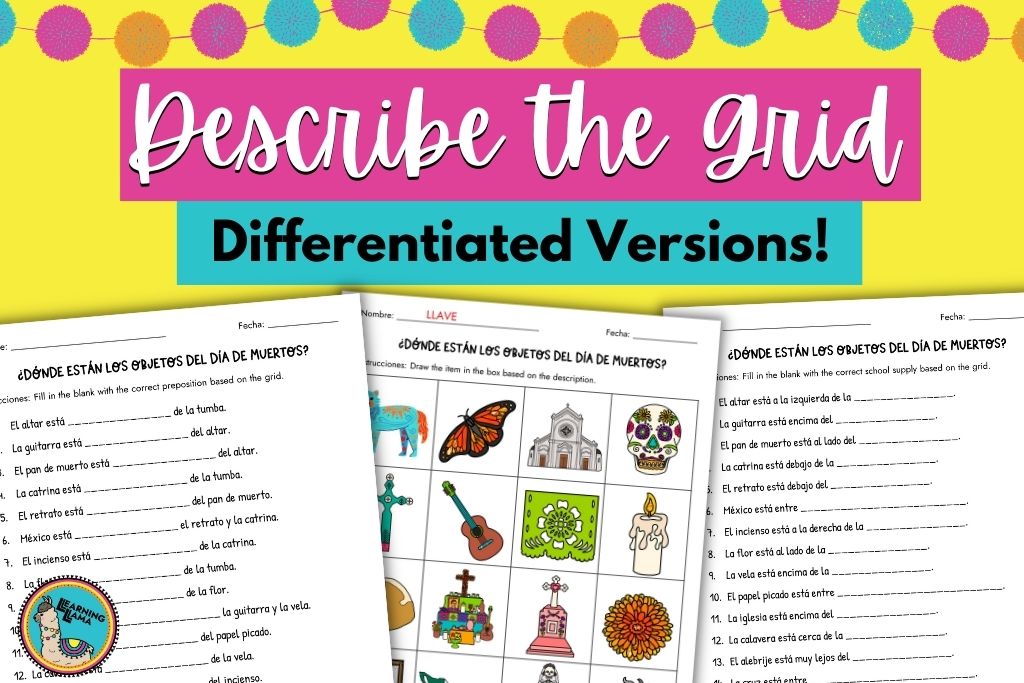
I have made 5 preposition grids that you can purchase here.
- Animals Prepositions Grid
- Day of the Dead Prepositions Grid
- Fruits and Vegetables Prepositions Grid
- Places Around Town Prepositions Grid
- School Supplies Prepositions Grid
If you purchase 4, you get the 5th set free with the bundle!
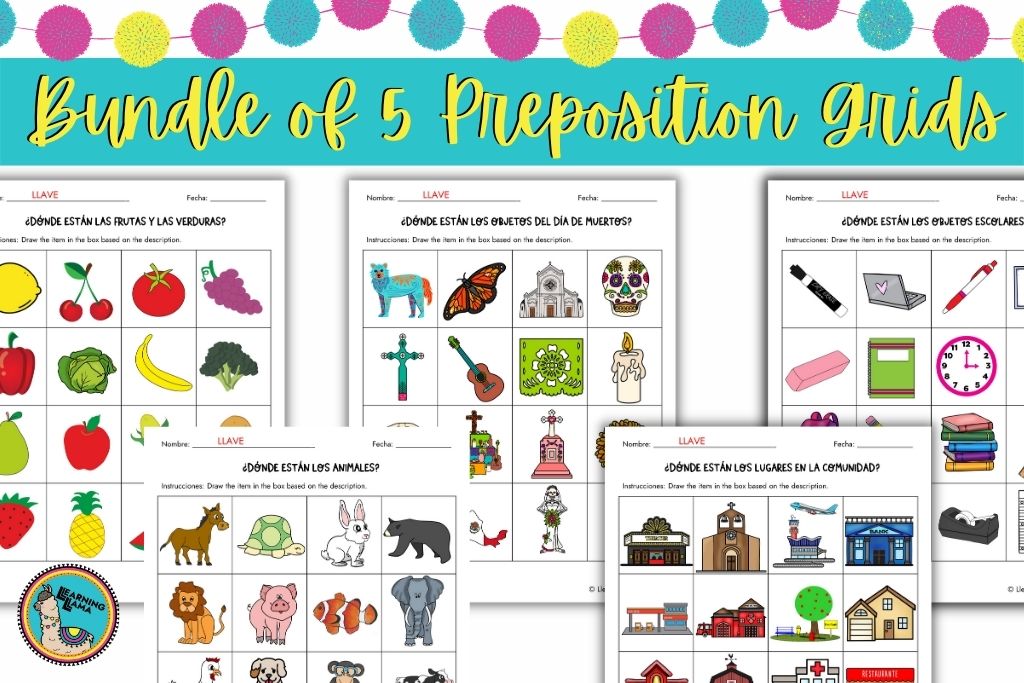
My Ideal School, City, House, Etc.
Allow your students to channel their inner designer or engineer with this fun activity. Depending on the vocabulary your students have at this point in the school year, let them design the school, city, house, mall, etc. of their dreams. Let’s take “City of your Dreams” as an example. Ideally, your students would have already learned the vocabulary for places around town, such as gas station, park, store, library. They will then draw the city of their dreams with at least 10 places. Below you will see an example of this project I did with my students. I made the city of my dreams: Nature City.
To practice with prepositions in Spanish, students will write a detailed description of the city of their dreams, explaining where each place is in relation to other places. For example: El jardín está al lado del zoológico. (The garden is next to the zoo.)
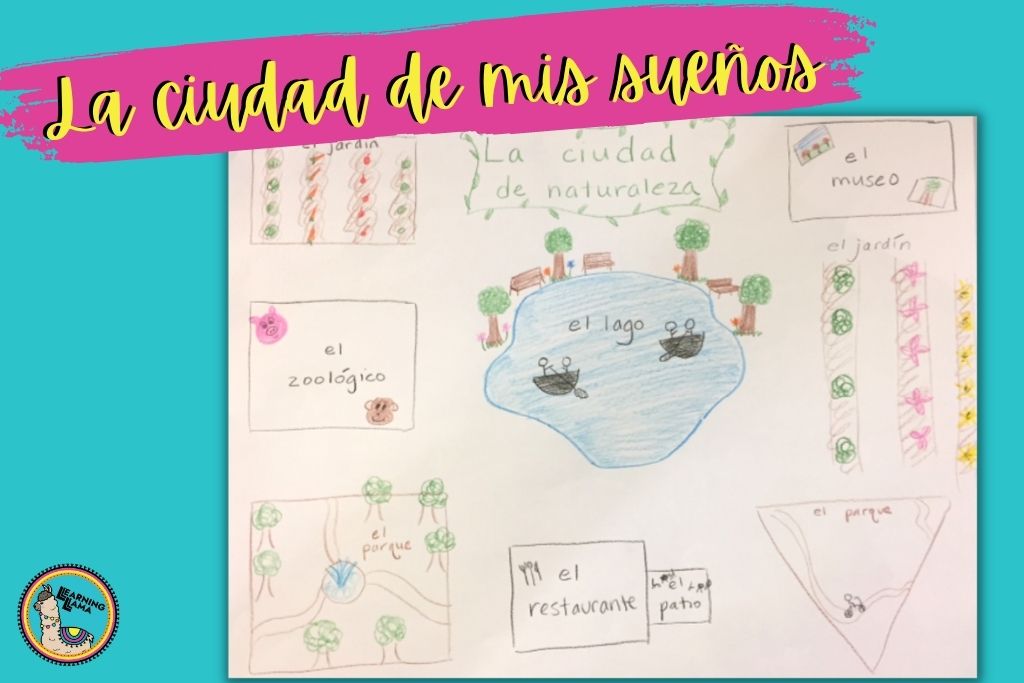
Pictionary
Write a bunch of simple sentences with prepositions of place. For example: La manzana está encima de la mesa. (The apple is on top of the table.) El gato está a la izquierda del perro. (The cat is to the left of the dog.) You want the sentences to be simple enough that all students can draw something… even those that are not confident in their artistic skills.
You can even have your students each write a sentence so they take part in all aspects of the activity. Then, put all of the sentences in a hat. Students will pull a sentence out, draw it, and the other students will guess what they drew.
Pear Deck
Pear Deck is one of my favorite technological tools for virtual learning. You simply take your Google Slides and share it with your students. They can draw, type, complete multiple choice, and so much more! Plus, Pear Deck allows you to see what every student is doing at the same time. I like using it for listening and drawing activities. It doesn’t require colored pencils shavings all over your floor or dried up markers after a few class periods. For example, I may say “La manzana está a la derecha de la fresa.” Students will draw what they hear me say.
I like to ask a variety of questions to keep my students on their toes and so the Pear Deck doesn’t get boring. Sometimes I have them draw based on the sentence they read. Other times I have the sentence and three images and they must circle the image that matches the description. Learn more about how I use Pear Deck and why I absolutely love it here.
Check out this Pear Deck for teaching prepositions.
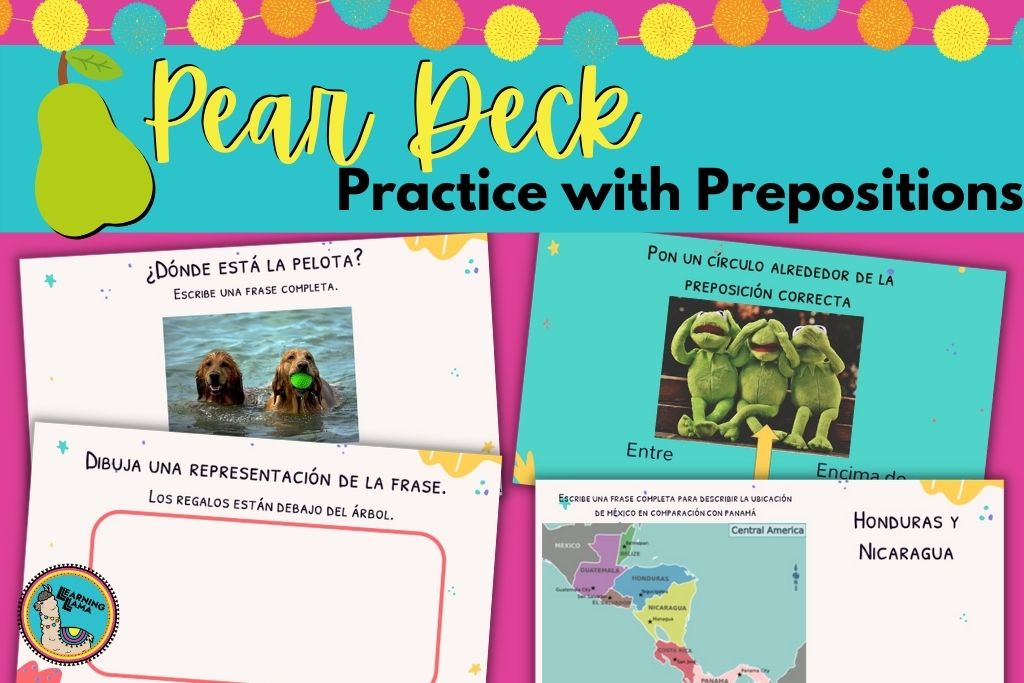
Describe the Painting
When I was teaching Spanish 3 Honors, I taught an entire unit on art. My colleague and I designed lessons for five different artists, and we had students emulate the various artists by creating artwork in the same style or genre as artists. For example, self portraits like Frida Kahlo, class murals like Diego Rivera, or their own Guernica-inspired Picasso artwork. We didn’t want to over-do it, as our students were drawing and creating a lot! So, we came up with an activity called “Describe the Painting” for our Salvador Dali unit. Dali’s paintings are perfect for this activity because there are so many little objects and moving pieces in his painting, and nothing is “real;” it is all surreal!
Students were given a Salvador Dali painting to study. They wrote a list of objects in the painting and began formulating a description for where everything was placed in the painting. Let’s take a look at “Still Life – Fast Moving” below. You could say “El cuchilo está encima de la mesa” and “La pera está a la izquierda del cuchillo.”

Once students were confident in their description, they found a classmate with a different painting who had not yet seen theirs. They kept their painting a secret, but described it in great detail to their partner. As the partner listened to the description, they drew what they heard. Encourage students to ask questions for clarification, making this a true interpersonal task. Then, once complete, they will compare their drawing to the original Dali painting and see how similar it is! You can get the lesson and activity here!
The beauty of this activity is that you can do it with any artist, any unit, and any level. As I said, I did this with Spanish 3 Honors, who already knew prepositions, but this was a great review. We were more focused on the artist, and the prepositions were an aide in the descriptions. If you’re studying family life, then Carmen Lomas Garza’s paintings about family and traditions would be perfect.
I hope these activities for prepositions in Spanish are fun for you and your students. If you have other ideas for teaching prepositions of place, let me know in the comments below!

